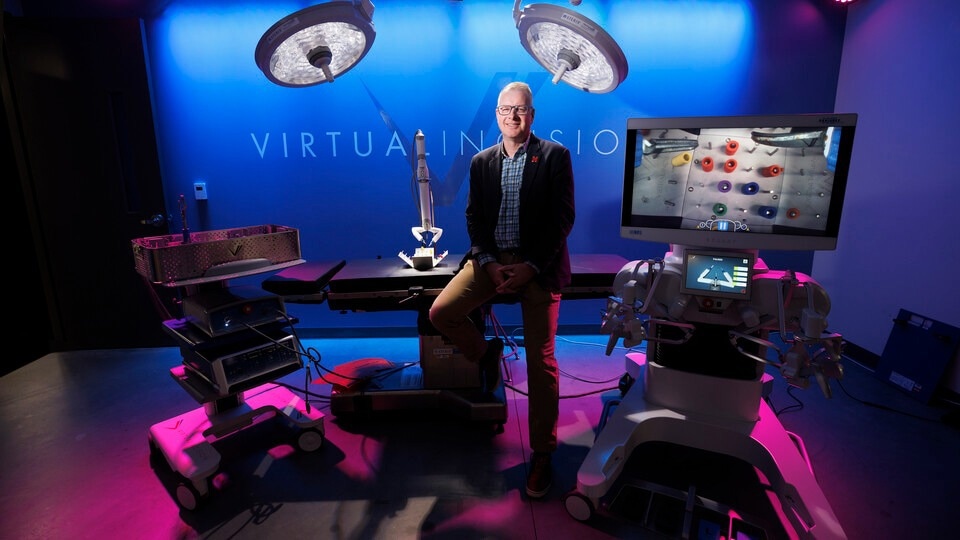Reviewed by Alex SmithAug 3 2022
Shane Farritor from the University of Nebraska-Lincoln is planning to launch a miniature robot into orbit to demonstrate its capabilities.
 Shane Farritor, the David and Nancy Lederer Professor of Engineering and chief technology officer of Virtual Incision, received the President's Excellence Award in April 2022 for his work to commercialize miniature surgical robots. Image Credit: Craig Chandler | University Communication and Marketing.
Shane Farritor, the David and Nancy Lederer Professor of Engineering and chief technology officer of Virtual Incision, received the President's Excellence Award in April 2022 for his work to commercialize miniature surgical robots. Image Credit: Craig Chandler | University Communication and Marketing.
The University of Nebraska-Lincoln was recently given $100,000 by NASA as part of the Established Program to Stimulate Competitive Research (EPSCoR) to help get the surgical robot ready for a 2024 test mission to the International Space Station.
NASA has been a long-term supporter of this research and, as a culmination of that effort, our robot will have a chance to fly on the International Space Station.
Shane Farritor, Professor, Engineering, University of Nebraska-Lincoln
Farritor is a co-founder of the Nebraska Innovation Campus-based startup business Virtual Incision. He and his coworkers have been developing the miniature surgical robot known as MIRA, or “miniaturized in vivo robotic assistance,” for almost 20 years.
Since its establishment in 2006, the business has garnered over $100 million in venture capital funding.
Farritor and engineering graduate student Rachael Wagner will write software, set up MIRA to fit inside a space station experiment locker, and thoroughly test the device over the course of the following year to ensure that it is robust enough to survive launch and that its systems will function as expected in space.
After that, they will have to wait almost a year for the robot to board the station.
Wagner, a native of Lincoln, started working with Farritor while still an undergraduate and joined Virtual Incision after earning her mechanical engineering bachelor’s degree in 2018. Later in 2022, a second graduate student could join the group.
MIRA has two major benefits. First, it can be placed through a minor incision, allowing medical professionals to do minimally invasive abdominal surgery. In earlier trials, colon resections were successfully completed using the device by surgeons.
Second, the technology might one day enable surgeons to operate from a distance, potentially treating a soldier hurt by an IED thousands of kilometers away or operating on an astronaut with a ruptured appendix on a Mars mission.
In a prior experiment, former NASA astronaut Clayton Anderson, who was at the Johnson Space Center in Houston, took control of the robot and ordered MIRA to carry out surgical-like activities in an operating room at the University of Nebraska Medical Center in Omaha, which was about 900 miles away.
MIRA will function independently during its impending journey within the space station, without the assistance of a physician or an astronaut. It will make surgical-simulating motions within an experiment locker the size of a microwave oven by cutting taut rubber bands and pushing metal rings along a wire.
These simulations are very important because of all the data we will collect during the tests.
Rachael Wagner, Engineering Graduate Student, University of Nebraska-Lincoln
It will be the robot’s most autonomous operation to date. Despite Farritor’s prediction that MIRA will operate autonomously in 50–100 years, the mission’s primary objective is to perfect the robot’s performance in zero gravity.
To preserve communications bandwidth on the space station and cut down on the amount of time that astronauts need to be involved with the experiment, the device is being set up to operate on its own.
Farritor added, “The astronaut flips a switch, the process starts and the robot does its work by itself. Two hours later, the astronaut switches it off and it is done.”
Farritor, the David and Nancy Lederer Professor of Engineering, is the company’s chief technology officer of Virtual Incision. He co-founded Virtual Incision with former professor of surgery Dmitry Oleynikov from the University of Nebraska Medical Center.
Farritor was chosen as the first recipient of the Faculty IP Innovation and Commercialization Award, which is an intellectual property award given out by the University of Nebraska system, in April 2022.
Farritor’s robotics study has received support from both NASA and the U.S. Army.
Farritor further stated, “As people go further and deeper into space, they might need to do surgery someday. We are working toward that goal.”